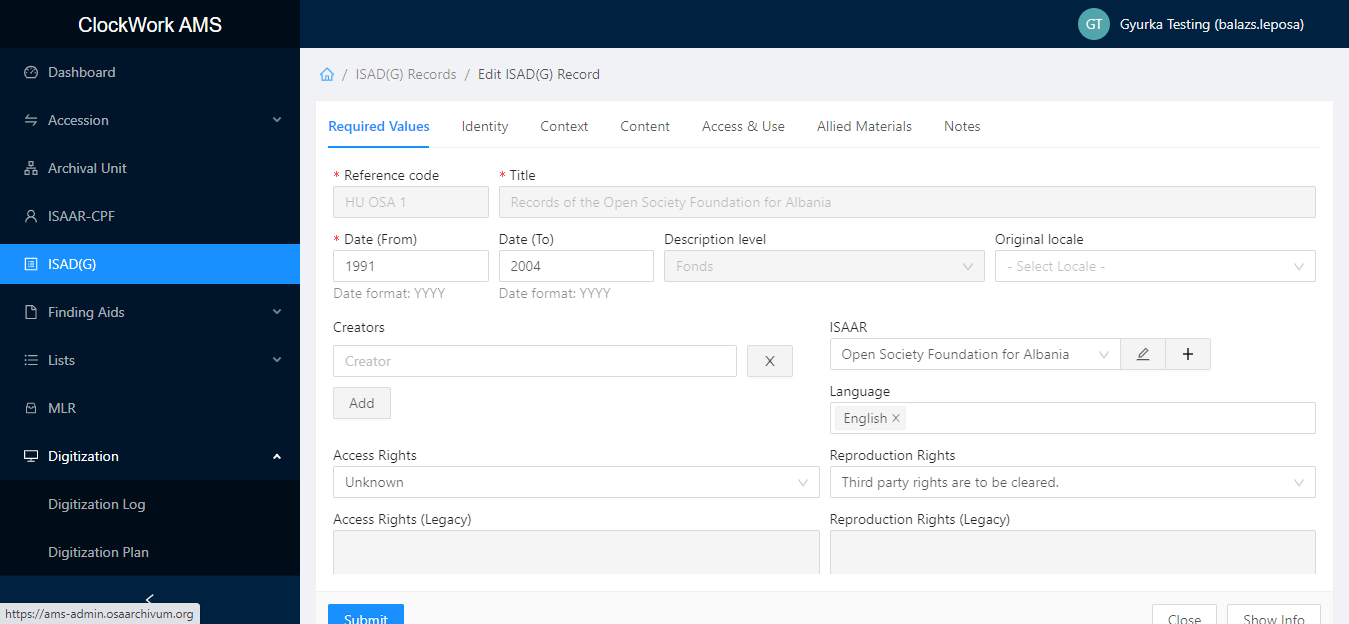Required Values Tab

Reference code
Standard Reference: ISAD(G) 3.1.1 Format: Automated. Purpose: To identify the unit of description. Rule: The reference code encompasses the following three elements: 1. the country code following the latest version of ISO 3166 Codes for the representation of names of countries; 2. the repository code following the national repository code standard or another unique location identifier; 3. a specific local reference code, control number, or another unique identifier. Example: HU OSA 41-3-2
Title
Standard Reference: ISAD(G) 3.1.2 Format: Automated. Purpose: To name the unit of description. Rule: Provide: 1. At higher archival hierarchical levels, a supplied title. This will include the name of the creator of the records. At lower levels supplied titles may include, for example, the name of the author of the document and a term indicating the form of the material comprising the unit of description and, where appropriate, a phrase reflecting function, activity, subject, location, or theme. 2. At lower archival hierarchical levels, a formal title or a concise supplied title by the rules of multilevel description and national conventions, OR 3. an abridged title, if the formal title is long, but only if this abridgment can be done without loss of essential information. Example: Jane Smith’s Personal Papers (fonds level, supplied title); Records of the Open Society Institute-Jordan (fonds level, supplied title); Correspondence (series level, supplied title); The North Atlantic Treaty (item level, formal title); Family Photographs, Italy 2002 (folder level, abridged title)
Date from, Date to
Standard Reference: ISAD(G) 3.1.3 Format: Date From YYYY Date To YYYY Purpose: To identify and record the date(s) of the unit of description. Rule: Record as a single date or a range of dates as appropriate. A range of dates should always be inclusive unless the unit of description is a record-keeping system (or part thereof) in active use. Record at least one of the following types of dates for the unit of description, as appropriate to the materials and the level of description. Date(s) when records were accumulated in the transaction of business or the conduct of affairs; Date(s) when documents were created. This includes the dates of copies, editions, or versions of, attachments to, or originals of items generated before their accumulation as records. Identify the type of date(s) given. Other dates may be supplied and identified by national conventions. Example: 1999-2000
Description level
Standard Reference: ISAD(G) 3.1.4 Format: Automated. Purpose: To identify the level of arrangement of the unit of description. Rule: Record the level of this unit of description. Example: Fonds; sub-fonds; series
Original locale
If the description of an archival unit is decided to be bilingual, the original language of metadata is to be indicated in this field. Format: Controlled vocabulary, drop-down list.
Creators
Standard Reference: ISAD(G) 3.2.1 Format: Free text. Purpose: To identify the creator (or creators) of the unit of description. Rule: Record the name of the organization(s) or the individual(s) responsible for the creation, accumulation, and maintenance of the records in the unit of description. The name should be given in the standardized form as prescribed by international or national conventions by the principles of ISAAR(CPF). Example: Varga, László
ISAAR
Standard Reference: ISAAR Format: linked to ISAAR records already created in the system. Purpose: To identify the creator (or creators) of the unit of description. Unlike the previous field, this field is a controlled field, linked with the ISAAR records created previously in the AMS. Therefore, if an ISAAR has been created, it will be able to be found in this field. Rule: Record the name of the creator, thereby linking the unit of description to the ISAAR record for the unit of description’s creator(s).
Language
Standard Reference: ISAD(G) 3.4.3 Format: Controlled vocabulary, drop-down list. Purpose: To identify the language(s), script(s), and symbol systems employed in the unit of description.Rule: Record the language(s) and/or script(s) of the materials comprising the unit of description. Note any distinctive alphabets, scripts, symbol systems, or abbreviations employed. Example: English
Access Rights
Standard Reference: ISAD(G) 3.4.1 Format: Controlled vocabulary, drop-down list. Purpose: To provide information on the legal status or other regulations that restrict or affect access to the unit of description. Rule: Specify the law or legal status, contract, regulation, or policy that affects access to the unit of description. Indicate the extent of the embargo and the date at which the material will open when appropriate. Example: Not restricted.
Reproduction Rights
Standard Reference: ISAD(G) 3.4.2 Format: Controlled vocabulary, drop-down list. Purpose: To identify any restrictions on the reproduction of the unit of description. Rule: Give information about conditions, such as copyright, governing the reproduction of the unit of description after access has been provided. If the existence of such conditions is unknown, record this. If there are no conditions, no statement is necessary. Example: Researchers do not have the right to distribute copies of the collection’s material.
Access Rights (Legacy)
This field contains legacy data from the previous archival metadata management system.
Reproduction Rights (Legacy)
This field contains legacy data from the previous archival metadata management system.
Accruals
Standard Reference: ISAD(G) 3.3.3 Format: Controlled vocabulary, drop-down list. Purpose: To inform the user of foreseen additions to the unit of description. Rule: Indicate if accruals are expected. Where appropriate, give an estimate of their quantity and frequency.

